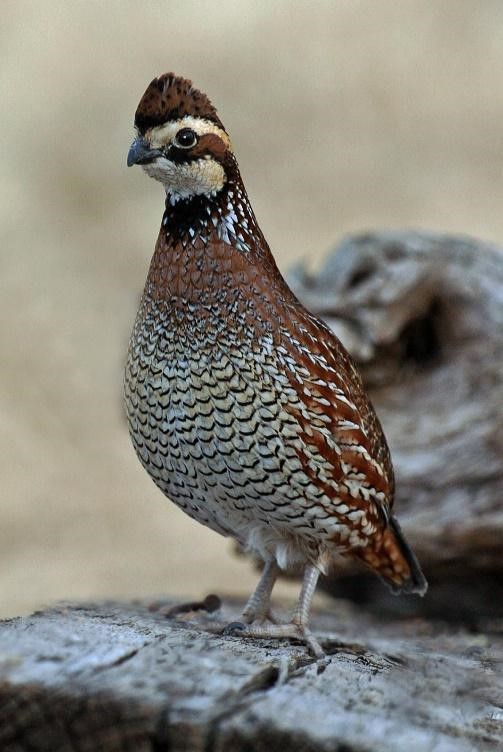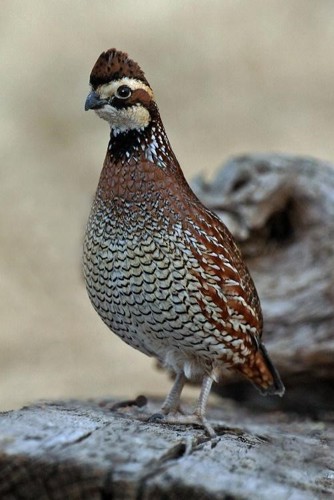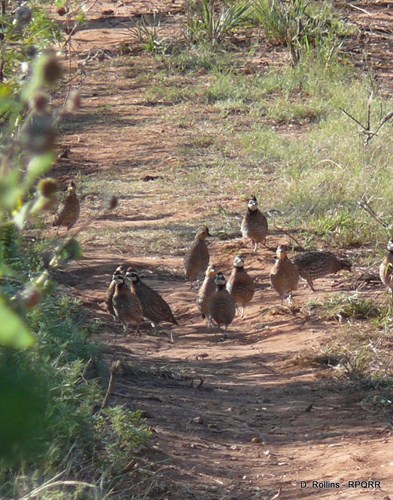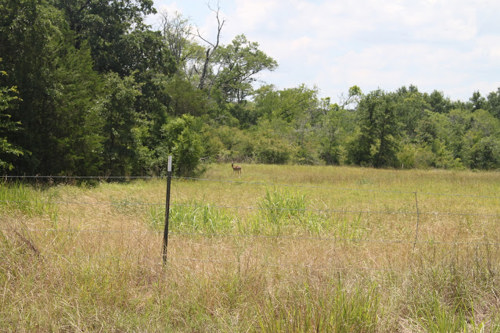How Much Space Does a Quail Need?
There is no doubt that quail are capable fliers when under pressure and strong, swift runners, but we rarely contemplate just how much distance they cover in a lifetime. When it comes to management of northern bobwhite (Colinus virginianus), it is critical to consider the amount of space they need to maintain sustainable coveys (groups) and healthy populations. When answering the question of how much space a quail needs, you must consider covey sizes, how much terrain quail can cross, and both the amount and quality of habitat that is present in an area that quail occupy.


A male northern bobwhite. Photo courtesy of R.D. Wilberforce
There is not a magic number of acres that will support a flourishing quail population, and the raw number of acres is less important than the amount and distribution of resources. Even so, it helps to have a general idea of the amount of space quail utilize. Experts agree that a maximum population density for quail is about 1-2 birds/acre, and a density of around 1 bird/2-4 acres is generally thought to be sustainable. Population densities at or below 1 bird/7-9 acres of land are considered poor (Guthery 1986). Groups of bobwhites, called coveys, tend to hold an average of 10-15 birds. About 15 acres of land will theoretically support one covey of quail, but research has shown that quail populations thrive on large tracts of contiguous habitat. Realistically, one covey would need considerably more space (Williams et al. 2004).
Within bobwhite populations, a certain amount of covey overlap is also necessary for survival, and “coveys in low density populations will be less able to maintain optimal group sizes, further depressing population growth rates and reducing the ability of populations to withstand high non-breeding season mortality” (Janke et al. 2013). It is crucial to have “sources and sinks” for quail so that populations can readjust and adapt in the face of environmental changes. It is also important to keep in mind that, even under perfect conditions, bobwhites are a “boom and bust” species and their numbers will fluctuate (sometimes dramatically) from year to year. As long as quail continue to have access to sufficient habitat, these natural cycles should not be a concern.

A covey of bobwhites. Photo courtesy of Dale Rollins
It is also worth remembering that, although quail generally do not move as far during their lifetime as some other bird species, they are not sedentary. The average bobwhite spends its life in an area of around 40 acres of land (Haines et al. 2004). For land to be suitable for quail, it must meet all of their habitat requirements every 40 acres at minimum. A fairly recent study suggested that to maintain a viable quail population, you must have an average of 800 birds and 2,500 - 3,000 acres of suitable habitat on which they can live (Stephens 2008). This density would give quail plenty of space to roam and a degree of flexibility in the event that the area is hit by a disaster, while still allowing coveys to intermingle and interact. Landowners with smaller parcels of land may find that discouraging, but they can meet their goals through cooperation among neighbors. Working together to create contiguous habitat and spreading awareness about the need for better land management for quail can benefit even the smallest quail populations. Increasing local quail densities is necessary for achieving long-term quail management success (Janke et al. 2013).
Even if quail technically have enough acreage to live on, there is no guarantee that the entire area is usable space for quail. According to Dr. Fred Guthery, a leading expert on bobwhites, the ideal habitat features native pasture grasses and forbs for nesting cover and food, stands of woody plants to provide refuge from predators, and ample bare ground free from vegetation and plant litter. Plant litter includes any dead plant material, like leaves and twigs, that has fallen to the ground and begun decomposing. Two ways to reduce plant litter on your property are to graze or burn the area. For nesting cover, Guthery suggests that landowners should aim for about 250 nest clumps/acre, but others recommend anywhere from 500 – 1,000 clumps/acre (Stephens 2008).

Quail habitat has a variety of grasses, forbs and woody cover. Photo courtesy of
Texas A&M AgriLife Extension
While the guidelines outlined above may be helpful, the density of birds on a property is ultimately determined by the quality of habitat. For example, 10 acres of native grassland with abundant food and cover is going to be able to support more quail than 10 acres of Bermuda grass pasture. Generally, “. . .[bobwhite] numbers tend to be higher and more stable when more edge is available and there are different types of edge” (Guthery 1986). Edge habitats are areas where two cover types intersect, such as forests and grasslands. These spaces generally have a greater variety of both plant and wildlife species and may be created using the management strategy of disking. Variety is key when sculpting bobwhite habitat, and with the correct combination of plant cover types and adequate space to inhabit, bobwhite populations can thrive on your land.

Edge habitat occurs where two other habitat types meet. Photo courtesy
of Texas A&M AgriLife Extension
For more information on the practice of disking, view our YouTube video: Disking for Quail Habitat in the Rolling Plains of Texas
Quail rely on various plants throughout their lives to avoid predation, survive extreme weather, raise young, and fulfill a host of other needs. Read more about the different types of plant cover they require and which plants they utilize: Plant Cover for Texas Quail.
Literature Cited
- Elmore, Dwayne et. al. Northern bobwhite habitat requirements and evaluation guide. Oklahoma Cooperative Extension Service, E-904.
-
Guthery, Fred S. 1986. Beef, Brush, and Bobwhites. Caesar Kleberg Wildlife Research Institute.
-
Haines, Aaron M., Fidel Hernandez, Scott E. Henke, and Ralph L. Bingham. 2004. Effects of road baiting on home range and survival of northern bobwhites in southern Texas. Wildlife Society Bulletin 32(2): 401-411.
-
Jackson, Alfred S., Clyde Holt, and Daniel W. Lay. 1987. Bobwhite quail in Texas: Habitat needs & management suggestions. Texas Parks and Wildlife Department. Reproduced from PWD-BK-W7000-0037-12/90.
-
Janke, Adam K., Robert J. Gates, and Mark J. Wiley. 2013. Covey membership and size dynamics in a low density population of northern bobwhites. Wilson Ornithological Society 125(4): 833-840.
-
Kellogg, Forest E., Gary L. Doster, and Lonnie L. Williamson. 1970. A bobwhite density greater than one bird per acre. The Journal of Wildlife Management 34(2): 464-466.
-
Stephens, Garry. 2008. Bobwhite quail management in south Texas. United States Department of Agriculture Natural Resources Conservation Service.
-
Williams, Christopher K., Fred S. Guthery, Roger D. Applegate, and Markus J. Peterson. 2004. The northern bobwhite decline: Scaling our management for the twenty-first century. Wildlife Society Bulletin 32(3): 861-869.
--
The Texas A&M Natural Resources Institute grants permission for authors, readers and third parties to reproduce and republish materials from its blogs, publications and online products through permission requests to NRI Communications at nri@tamu.edu. This includes the use of figures, maps, photography and video media. If you have questions about permissions, please contact Brittany Wegner.




